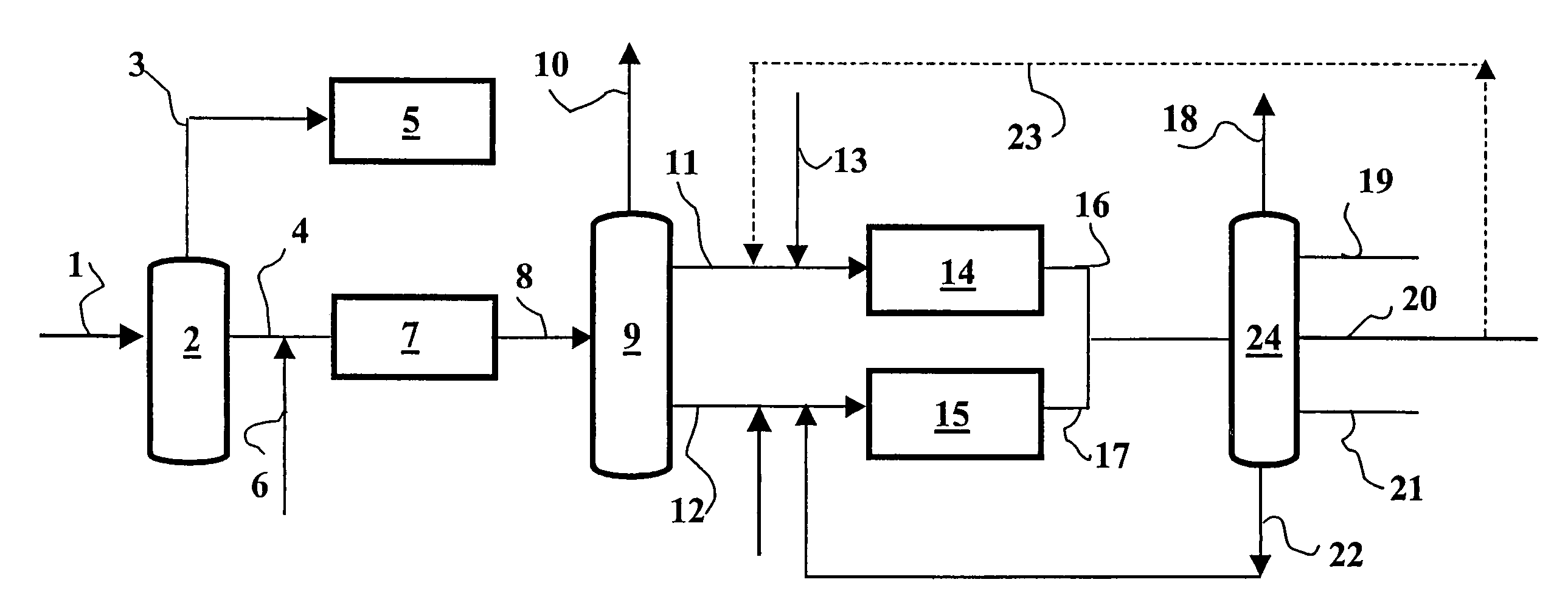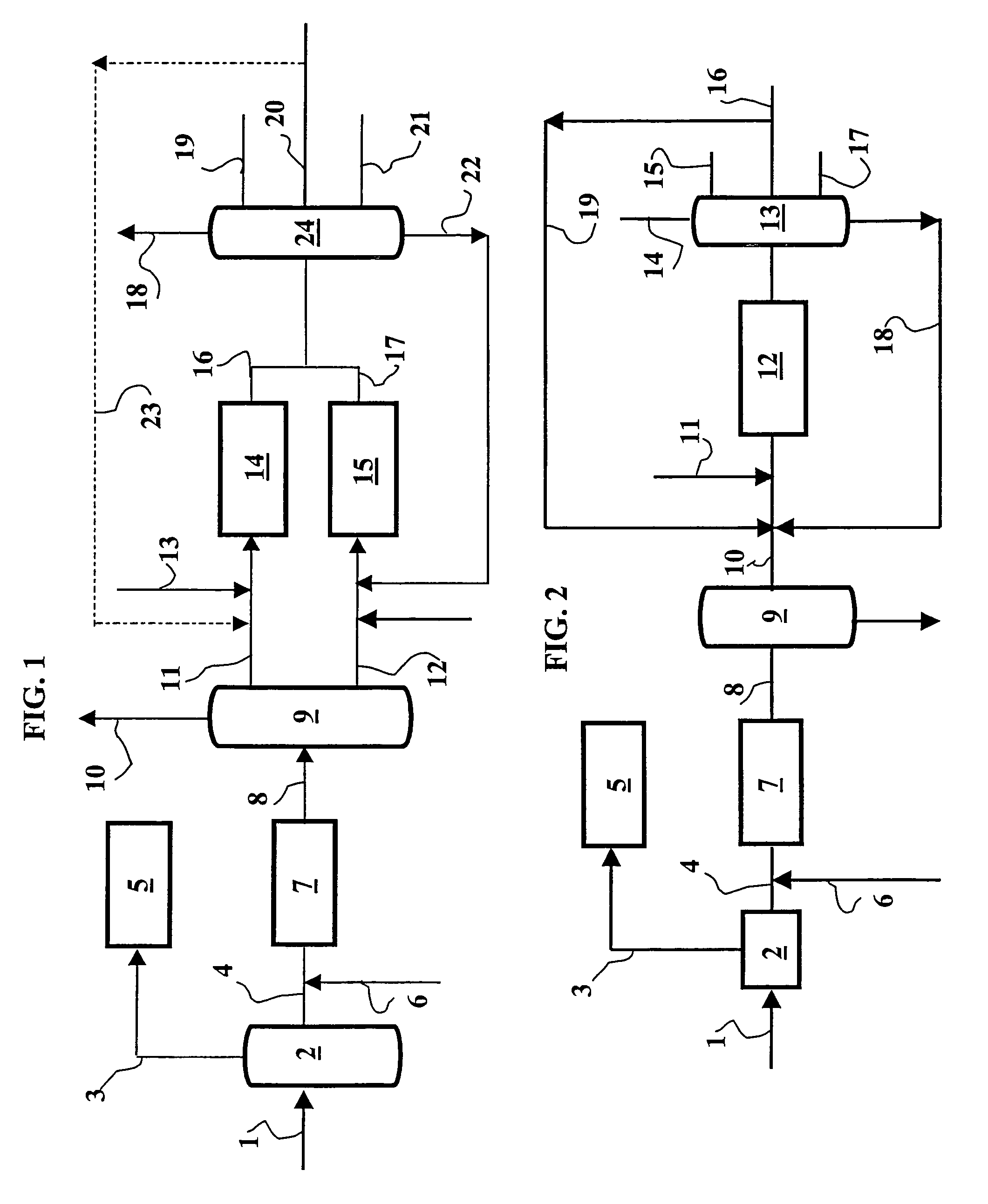Method for the production of middle distillates by hydroisomerisation et hydrocracking of charges arising from the Fischer-Tropsch method
a technology of hydroisomerization and distillate, which is applied in the direction of organic compound/hydride/coordination complex catalyst, physical/chemical process catalyst, metal/metal-oxide/metal-hydroxide catalyst, etc., can solve the disadvantage of silica-alumina-containing catalysts, macropores
- Summary
- Abstract
- Description
- Claims
- Application Information
AI Technical Summary
Benefits of technology
Problems solved by technology
Method used
Image
Examples
example 1
Preparation and Moulding of a Silica-Alumina Which can be used in the Process According to the Invention (SiAl-1)
[0365]Aluminium hydroxide powder was prepared according to the process described in the patent WO 00 / 01617. This powder is mixed with a silica sol prepared by exchange on decationizing resin, then filtered. The composition of the support mixed with anhydrous product is, at this stage, 70% Al2O3-30% SiO2. The moulding is carried out in the presence of 12% nitric acid with respect to the anhydrous product. The kneading is carried out on a kneader with Z-shaped arms. The extrusion is carried out by passing the paste through a die with orifices 1.4 mm in diameter. The extrudates of SiAl-1 support thus obtained are dried at 150° C. then calcinated at 550° C. then at 750° C. in the present of water vapour.
[0366]The characteristics of the support are the following:
[0367]The composition of the support is 70% Al2O3-30% SiO2.
[0368]The BET surface is 242 m2 / g.
[0369]The total pore vo...
example 2
Preparation and Moulding of a Silica-Alumina Which can be used in the Process According to the Invention (SiAl-2)
[0385]The silica-alumina SiAl-2 according to the invention is prepared starting with a totally soluble silica-alumina obtained by any technique known to a person skilled in the art, to which a sodium silicate solution is added. The method of operation is as follows: in the first instance, a 30% sulphuric acid solution is added to a sodium silicate solution. The quantity of H2SO4 is defined in order to work at a fixed neutralization rate. The addition is carried out over two minutes under agitation of 600 rpm. The synthesis temperature is 60° C. The ripening period has been fixed at 30 minutes. Agitation is maintained at 600 rpm, the temperature is that of the previous stage. Then (Al2(SO4)3 (500 ml) is added, the concentration is fixed by the desired alumina content. The pH is not regulated and is fixed by the desired alumina content. The addition is carried out over 10 m...
example 3
Preparation and Moulding of a Silica-Alumina Which can be used in the Process According to the Invention (SiAl-3)
[0405]The SiAl-3 support is prepared starting with the SiAl-2 support in dried extruded forms and calcinated by TEOS (tetraethoxysilane) impregnation according to the method described by B. Beguin, E. Garbowski, M. Primet in “Journal of Catalysts”, page 595, volume 127, 1991. Then the impregnated extrudates are dried at 120° C. for 15 hours, calcinated at 530° C. under a current of dry air for 2 hours then calcinated at 700° C. in the presence of water vapour.
[0406]The sample thus obtained is named SA2.
[0407]The extrudates thus obtained are dried at 150° C., then calcinated at 550° C.
[0408]The characteristics of the SA2 support are the following:
[0409]The composition of the support is 47.7% Al2O3-52.3% SiO2.
[0410]The BET surface is 282 m2 / g.
[0411]The total pore volume, measured by nitrogen adsorption, is 0.41 ml / g.
[0412]The average pore diameter, measured by mercury poros...
PUM
| Property | Measurement | Unit |
|---|---|---|
| Temperature | aaaaa | aaaaa |
| Temperature | aaaaa | aaaaa |
| Temperature | aaaaa | aaaaa |
Abstract
Description
Claims
Application Information
 Login to View More
Login to View More - R&D
- Intellectual Property
- Life Sciences
- Materials
- Tech Scout
- Unparalleled Data Quality
- Higher Quality Content
- 60% Fewer Hallucinations
Browse by: Latest US Patents, China's latest patents, Technical Efficacy Thesaurus, Application Domain, Technology Topic, Popular Technical Reports.
© 2025 PatSnap. All rights reserved.Legal|Privacy policy|Modern Slavery Act Transparency Statement|Sitemap|About US| Contact US: help@patsnap.com



